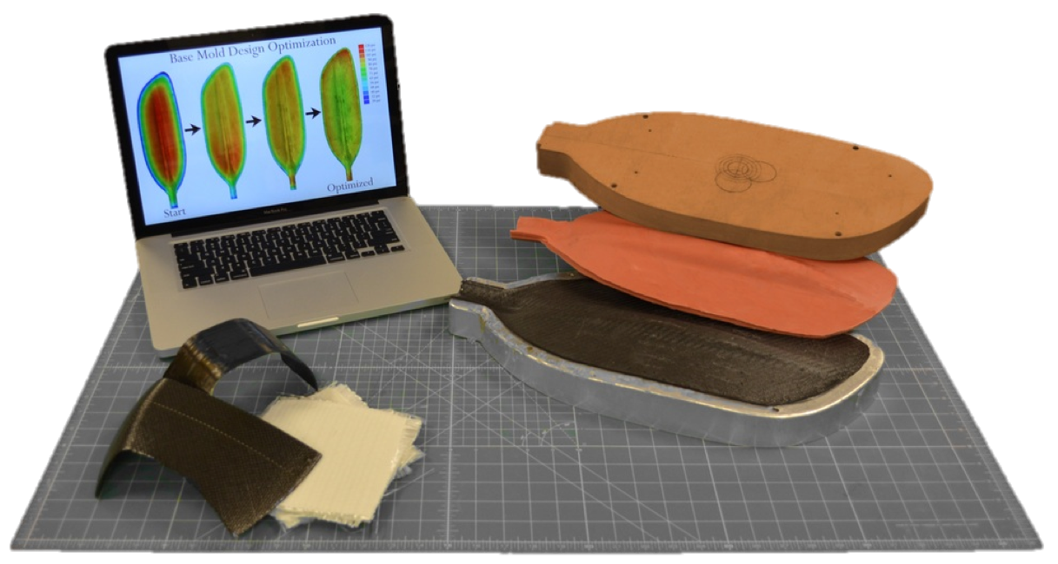With a world in constant need of lighter and stronger products, advanced composite materials (including carbon-fiber) hold great promise. However, traditional composites manufacturing has remained nearly unchanged for the last 50 years; making it extremely expensive, labor intensive, and environmentally taxing. It’s time for change.
Vistex Composites offers a patented manufacturing process that has helped usher in that change. Vistex utilizes proprietary software to optimize custom molds designed to provide superior performance in composites manufacturing.
What problem is Vistex Composites trying to solve? How are you solving the problem?
Traditional composites manufacturing is slow and expensive because it relies on tedious, labor-intensive processes. The other piece is that traditional manufacturing also creates waste.
Vistex Composites has developed a process, using a customized Pressure Focusing Layer, that achieves the uniform pressure and uniform temperature required to make a composite by a much more efficient approach, as compared to the current gold standard, autoclaving. We have developed computer software and optimization algorithms to design and optimize manufacturing molds. Part of the technology is that we’re able to rapidly heat and cool our molds, which increases throughput. Alternatively, we can keep molds at temperature and cycle material in and out. There’s also an added benefit – if we can increase our throughput, we can make more products on a given mold. If you can reduce the number of molds that are needed for a production run, that can be a substantial amount of money.
How are you thinking about and quantifying impact metrics?
We quantify our metrics in a few ways, and it depends on the specific needs of the customer.
Some customers are very interested in the energy-savings aspect of our technology. We’ve demonstrated that we can reduce energy consumption by 90%, or even more in some cases. We’ve quantified the amount of energy savings – for one of the products that we produced using our technology it was found that for every 150 square feet of product (approximately 150 kayak paddles) it saved the amount of energy that the average US household uses in one year. Multiplied across entire industries, the energy and environmental benefits are staggering!
But the most important metric for customers is always cost. Vistex is able to save money both in capital equipment (Cap-Ex) and in the process of producing the good (Op-Ex). For example, companies that are looking to expand their capabilities often spend upwards of $10M+ to outfit their facility with a large autoclave but we could achieve similar throughput capabilities with two or three manufacturing cells costing just $200K each. Because Vistex is able to reduce or even eliminate many of the tedious manual processing steps and disposable bagging materials used in competitive processes, we are able to significantly increase throughput while reducing production costs. For one of our customers, it is the reduced complexity of Vistex’s processing steps that is leading to adoption. As the ability to combine Vistex’s production technology along with robotic automation enables very repeatable processing, and results in exceptional quality products.
The other metric we’ve found to be critical for our customers has been time-to-market. For a company that’s developing a new product, we can engineer a custom mold for them to make their product properly and correctly the first time, as opposed to competitive processes that can take many months, or years to implement. We have one customer we’re working with now who had spent years trying to get another method to work. They just kept wasting time and money with their old techniques, years of design iterations and defective parts later, they’ve finally made the switch to our process and we have solved their problems in under 6 months!
Are customers open to adopting your technology?
Early on, when we were just getting started, this was difficult, as customers saw a new technology as risky. We started out by validating our technology across a wide range of industries like sports equipment (kayak paddles), safety products (helmets) and wind energy (blades). We are working on a lot of exciting opportunities right now. We are currently producing components for UAV/UAS (drone) systems, developing automotive components in partnership with OEMs and materials companies, and designing and building the next generation composite booms for NASA.
We’ve also recently signed a Joint Development Agreement with one of the world’s largest materials companies in order to pursue specific opportunities in the aerospace market that have incredible growth potential.
What does competition look like?
There’s a handful of other technologies and methods that people are trying to develop to displace the autoclave, which is just a large, pressurized oven. Techniques like resin transfer molding (RTM) offer some throughput advantages over autoclaving, but they often struggle with defects in the form of voids, and many industries simply can’t have that. Different materials like sheet molding compounds, can be formed into the product shape very quickly, but the size of the fiber reinforcements that can be included in these materials is small, and the ratio of the fibers [the portion of the composite that gives the product its strength] in the material is low.
Where we are differentiated in the market is that we offer our customers scalable production volumes, but with low CapEx and OpEx. We’ve also demonstrated that we are able to handle products with complex features such as undercuts, that other techniques simply cannot achieve.
After Vistex Composites succeeds, what does the future look like? What's next after that, in terms of the market?
We will make composite products more accessible for more markets. These are strong, lightweight products that can offer so many benefits, like fuel savings and emission savings. What’s exciting for us is we’re able to save energy, save pollution, save costs in the manufacturing process, which then enables those products to save more energy, reduce more emissions. It’s like a snowball effect, where we enable those environmental benefits on the production side, which allows for better products while they’re in use.
Outlook
Vistex Composites is solving a big problem for the manufacturing sector. Traditional methods and processes are lengthy and expensive. As a result, only large companies can afford these high cost and slow manufacturing processes. However, some of these companies are now demanding a higher throughput. For instance, the automotive market is looking for a one-minute effective cycle time. Vistex Composites brings speed efficiency to the sector, and their thermoplastic composites are also recyclable.
About The Author

Daniel currently works at Lawrence Livermore National Laboratory. His original assignment was to maintain and update facility safety documentation for all facilities on-site, and perform risk analysis. Over time, his role has expanded to leading continuous improvement efforts through product management.
Concurrently, Daniel volunteers with Techstars, helping organize startup weekends, and with the American Institute of Chemical Engineers, organizing events on the local and national levels of the organization. He also volunteers with One World, and previously with Powerhouse Ventures, to source and screen startups for potential investment.
Daniel holds a BS in Chemical Engineering from UC Davis, and recently completed coursework in energy innovation from Stanford. His passion is at the intersection of sustainability, innovation, and business.

